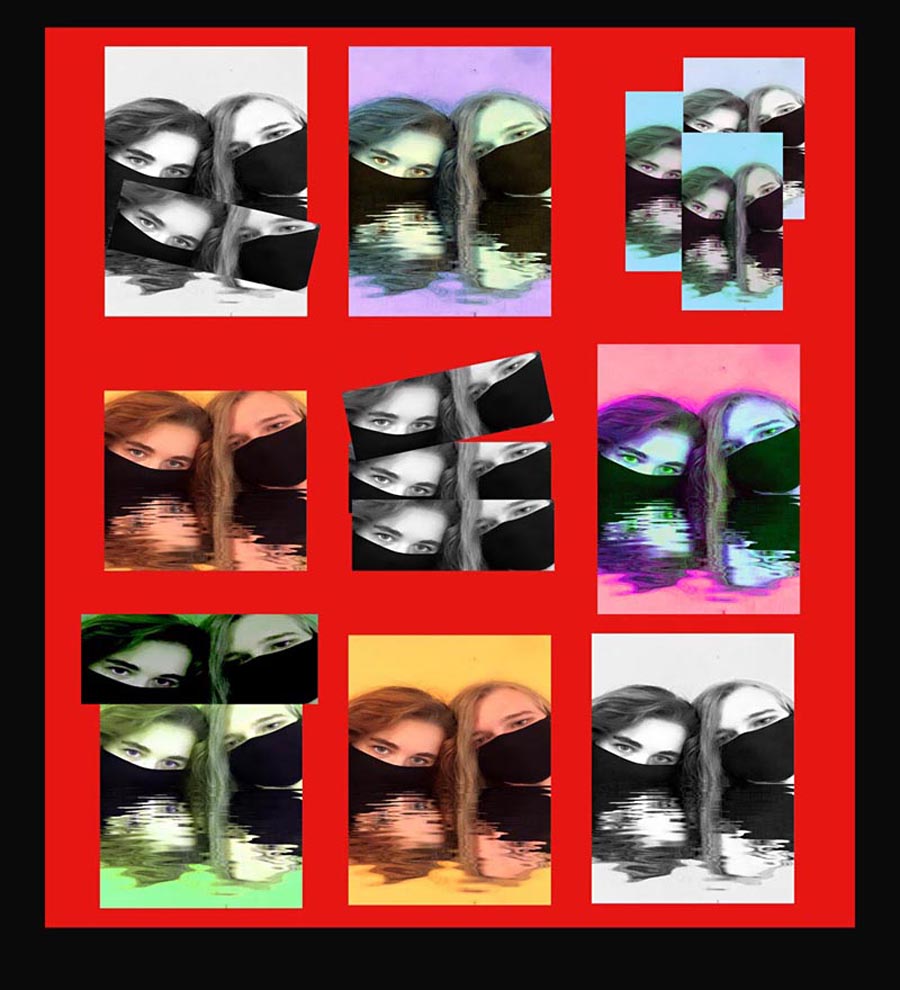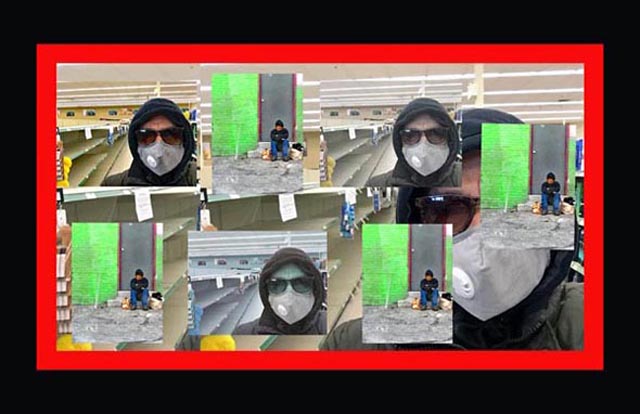| Home | Conference video | Project Video | Pam Patterson |
Daniel Payne | collaborators bios |
in the CYCLONE of COVID-19
Joanna Black

Joanna Black – My Generation, 44” Hx40” W, photo-digital print,2020.
As the cyclone of COVID-19 emerged in the early winter months of 2020, I witnessed our lives changing furiously: the pandemic swiftly moved into North America, first invisibly with announcements it was spreading, and then discernibly in mounting illnesses and deaths. On March 12th the pandemic emerged with the first presumptive case in my own province, Manitoba. On Friday the 13th, I ceased face-to-face interaction with people whom I worked with and my professional life moved online. A state of emergency was declared one week later. It took only 15 days from the first Manitoban COVID-19 case to the first death. By March 31st, all educational institutions, stores except essential services—dentists’, doctors’ offices, and international travel were effectively closed or moved online (“A Timeline of COVID-19 in Manitoba” 1). By September 6th, 2020 we faced over 27 million cases of COVID-19 worldwide (@Worldometer). Currently our streets are effectively silenced.
I grew up in the 1960’s. The baby boomer generation lived under the threat of Cold War and nuclear annihilation, yet the world looked hopeful and many in the post-war aftermath viewed it as prosperous, economically stabile, and promising (Hamilton and Hamilton 1). Indeed, boomers are often considered the lucky generation (Fingerman and Doblin-MacNab 238; Hamilton and Hamilton 2; Mackay 60) in which young people lived for the moment (Hamilton and Hamilton 2; MacKay 62).
Youth in the 1960s believed they could transform the world and were at the forefront of radical societal change through protesting civil, human rights and feminist issues. This radicalism, however, posed such an imposing threat (Chomsky, 2016,“Requiem for the American Dream”) that leading North American plutocrats, according to Chris Hedges, began a campaign in 1971 initiated by Lewis Powell, an American corporate attorney. Powell argued corporations had to counteract the effective campaigning of the boom generation in order to constrain, and hinder widespread anti-corporate ideas in universities, religious institutions, media, and the academic press (Hedges). He was successful: neoliberalism morphed into a giant in the last few decades.
The 1960s were the era of Pop Art, and artists such as Andy Warhol celebrated mass production, common culture, and advertisements. Attractive bright colours, layering and repetition were common pictorial techniques. In the USA, artists were inspired by their life experiences (Tate Gallery). The artwork, My Generation, is a response to the image of youth in 2020. A prominent Rock and Roll group wrote these lyrics about the angst of teenagehood:
…Things they do look awful c-c-cold…
I hope I die before I get old
My generation… This is my generation …
Why don’t you all fade away
Talkin’ ‘bout my generation…
--The Who, “My Generation”
One of the musicians in the group, Pete Townshend, offered a personal reflection about this song. It “…was very much about trying to find a place in society. I was very, very lost” (Rolling Stone).
I ask myself the same question now for youth today confronting COVID-19. The disparity between rich and poor is accelerating: for example, by August 21, 2020 American billionaires in New York City alone had increased their net worth by $77 billion during the pandemic (Democracy Now). In the United States and worldwide, in our neoliberal age, COVID-19 is causing economic catastrophe, mass unemployment, poverty, illness, mental health deterioration, and deaths (Davis; Kettner; “The Global Economic Outlook”). Meanwhile, while COVID-19 rages on, Noam Chomsky warns the greatest risk to humankind is global warming and nuclear warfare (qtd. in Democracy Now). Yet, as Rutger Bregman argues, humankind is creative, collaborative, trusting, kind, caring, generous, and altruistic. These qualities have allowed us to survive until now.
In the digital age, the Instagram image-based site dominates amongst teens (ORC at the University of Chicago). Depicted in My Generation are two lovers in an Instagram image, their togetherness, their expressions and protection of masks living in the age of COVID-19. As an artist, educator and parent concerned about our young adults, I ask during this traumatic time: What will they write for themselves about their generation and their experiences? What is their perception of their place in our society today?

Joanna Black, A Covid-19 Self Reflection
84.3” H X 16.7” W, photo digital print. 2020.
A Covid-19 Self-Reflection was taken in a small Ontario northeast town one hot summer day in 2019. I was startled to find the sense of emptiness, loneliness, starkness, and quiet. The town had been transformed from a typical bustling cottage center to one of emptiness, loss, and solitude. People in the downtown core were replaced by a multitude of signs plastered on storefronts from one street to another. Looking into a storefront window I only saw myself staring back with a blockade of words echoing “loss,” “refuge” and “retreat”. The digital/face-to-FACE RELATE/ions I confronted was with myself alone with my camera.

Joanna Black, Food Security – 52.5” H X 81” W, photo digital print. 2020.
During COVID-19 as the pandemic unfolds, people have been alarmed by the potential rise in food insecurity throughout the world. Internationally, businesses, governments and organizations are escalating careful and prolific measures to keep high quality agriculture and food systems operating safely, stably, with distribution supplies running smoothly. With new escalating problems including hardships regarding adequate food distribution, food trade issues, food inflation, chain disruptions, currency devaluations in some countries, and a great loss of jobs, food security risks are compounded during the pandemic. The U.N. World Food Programme has disseminated the dire warning that by the end of 2020 the world could face 130 million people suffering acute food insecurity (The World Bank, November 2020). In Canada food insecurity is being challenged by market instability, dissemination challenges, and increased food costs as we head into the future: indeed as Holland argues, food safety should not be taken for granted (Holland, 2020, p.6). For this artwork photographs were taken during a food shopping excursion in the pandemic at Sobeys, a common Canadian grocery store. As well, photographs were also taken in the downtown area of Winnipeg, Canada near a foodbank and the Canadian Museum for Human Rights.
@Worldometer. “Coronvirus Cases.” Last modified 7 September 2020,
https://www. worldometers.info/coronavirus/?utm_campaign= homeAdvegas1?. Accessed 8 Sept. 2020.
“A Timeline of COVID-19 in Manitoba.” CTV News, last modified 7 September 2020,
https://winnipeg.ctvnews.ca/a-timeline-of-covid-19-in-manitoba-1.4866501. Accessed 7 Sept. 2020
Bregman, Rutger. Humankind: A Hopeful History. Little Brown and Company, 2019.
Chomsky, Noam. “Nuclear Weapons, Climate Change & the Undermining of Democracy Threaten Future of Planet”. YouTube, 12 April 2019, https://www.youtube. com/watch?v=h_HSPpGEJCo. Accessed July 22 2019.
“Coronvirus (COVID-19).” Google News, 6 Sept. 2020. https://news.google.com/covid 19/map?hl=en-CA&mid=%2Fm%2F02j71&gl=CA&ceid=CA%3Aen. Accessed 6 Sept. 2020.
Democracy Now. “News: August 21 2020.” Democracy Now --Daily News, 2020,
https://www.youtube.com/ watch?v=tZbUdQohaE8. Accessed 21 Aug. 2020.
Fingerman, Karen and Dolbin-MacNab Megan. “The Baby Boomer and their Parents: Cohort Influences and Intergenerational Ties.” The Baby Boomers Grow Up: Contemporary Perspectives of Midlife, edited by Susan Krauss Whitbourne and Sherry L. Willis, Routledge, 2006, pp. 237-260.
Hamilton, Myra, and Clive Hamilton. “Baby Boomers Retirement, Dreams Fears and Anxiety.” The Australian Institute and University of Sydney, Discussion Paper 89, September 2006, ISSN 1322-5421. https://www.researchgate.net/publication/237330909
Baby_Boomers_and_Retirement_Dreams_fears_and_anxieties. Accessed 14 Aug. 2020.
Hedges, Chris. “The Silencing of Dissent.” Truthdig, 2017, https://www.truthdig. com/articles/the-silencing-of-dissent/. Accessed 22 July 2019.
Holland, K. (2020). “Canada’s Food Security During The COVID-19 Pandemic”, The University of Calgary, 13(3), https://www.policyschool.ca/wp-content/uploads/2020/06/Food-Security-Holland.pdfAccessed November 15, 2020.
Mackay, Hugh. Generations: Baby Boomers, their Parents and their Children. Pan Macmillan Publication, 1997.
ORC at the University of Chicago. "New Survey: Snapchat and Instagram are Most Popular Social Media Platforms among American Teens." ScienceDaily, 21 September 2017, https://www. sciencedaily.com/releases/2017/04/170421113306.htm. Accessed 3 Sept. 2020.
Rolling Stone.“500 Greatest Songs of All Time.” Rolling Stone Magazine, 7 April 2011, https://www.rollingstone.com /music/music-lists/500-greatest-songs-of-all-time-151127/. Accessed 14 Aug. 2020.
Tate Gallery. “Pop Art.” https://www.tate.org.uk/art/art-terms/p/pop-art. Accessed 1 Sept. 2020.
The Who. “My Generation-Lyrics.” Genius, 1965, https://genius.com/The-who-my-generation-lyrics. Accessed 26 Aug. 2020.
The World Bank. Food Security and COVID-19. 2020. https://www.worldbank.org/en/topic/agriculture/brief/food-security-and-covid-19
| Home | Conference video | Project Video | Pam Patterson |
Daniel Payne | collaborators bios |